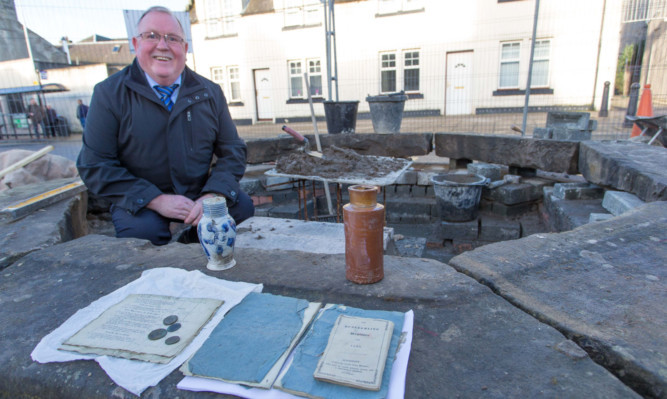An ancient Fife market cross has given up its long-held secrets.
It was when work was being undertaken to conserve Kincardine’s 17th Century High Street cross, a Historic Scotland-recognised nationally important landmark, that a mystery time capsule was unearthed.
A series of Mason’s marks were revealed, showing the cross had already been dismantled, renovated and re-erected in 1830.
Lain undisturbed for centuries, its time capsule artefacts give a fascinating snapshot of life in the Forth-side village.
The landmark has stood in the centre of Kincardine’s market place since 1663, when the town was created as a burgh of barony under Alexander Bruce, the second Earl of Kincardine.
Included in the casket, deep in the foundations of the octagonal cross, were two pieces of pottery.
One was a Staffordshire-ware single-handled flagon with a medallion commemorating King George III and the second was a stoneware jar stamped Blacking Bottle, which contained black polish dating from between 1817 and 1834.
There were three coins from the reign of George III a halfpenny dated 1806, a farthing dated 1823 and a silver sixpence from 1819.
It also gave up more local treasures, including the Dunfermline Register for 1829.
The booklet was a cross between an area directory and almanac. Listings include local nobility and knights, clergy, justices of the peace, MPs and police commissioners, alongside dates of local events such as market fairs and ferry passage schedules.
Kincardine was a bustling port at that time and three items were obviously of such local importance that they made their way into the capsule as well.
Also included was a contract among the ship owners belonging to the district of Kincardine for the insurance of their vessels and a schedule of premiums for the Kincardine Assurance Association, which also lists the sea-borne trade and the destinations Kincardine ships were sailing to at that time.
While it is not quite out with the old and in with the new, a modern time capsule has now gone into the foundation of the cross, ready to be unearthed by future generations.
Kincardine Community Council took the chance to celebrate the rare find of the 1830 one by placing new treasures inside.
It contains a picture of Alexander Bruce, the second Earl of Kincardine and the man who arranged for the cross to be erected originally, from his descendant Lord Elgin.
Fife Council placed inside information of the funding and project team for the reconstruction while Kincardine Primary School put in a copy of the school roll.
The community council itself stashed away ribbons from the opening ceremonies of both the Kincardine bypass and coastal path, a medallion presented by the community council to local children at the millennium, a pouch with coins from 2014 and a mug.
The local history group also put in four books on the history of the community and a mug.
Work was instigated in the first place because of the community council’s concerns about the cross’s stability.
